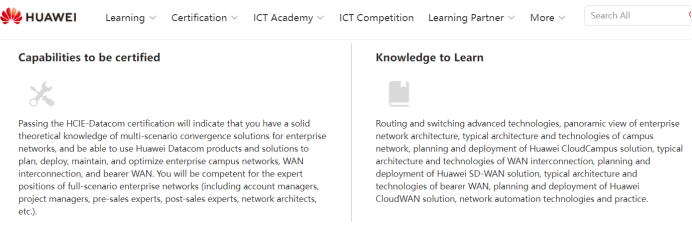Many candidates often ask:
“Both HCIP and HCIE are Huawei certifications. Technically, what’s the real difference? If I’ve passed HCIP, does preparing for HCIE just mean learning a bit more advanced configuration?”

As a senior network engineer, let me break down the core differences between HCIP and HCIE from three perspectives: technical depth, capability requirements, and scenario adaptation. I’ll also share some exam preparation advice using dumps, to help you avoid the common mistake of thinking “mastering HCIP is enough to pass HCIE.”
Core Insight: Application Skills vs. Architectural Capability
HCIP and HCIE are not simply a “basic vs. advanced” upgrade. Instead, they represent different types of expertise:
• HCIP = Applied technical skills: knowing the standard process and executing tasks step by step.
• HCIE = Architectural capability: being able to design optimal solutions and solve unknown or complex problems.
The exam focus, technical emphasis, and preparation logic are fundamentally different.
Technical Positioning of HCIP vs. HCIE
Across domains like Datacom, Cloud, and Security, Huawei has clear positioning for both certifications. This directly determines their exam content and ability requirements:
• HCIP (Intermediate): Enterprise-level implementation & O&M expert
• Focus: Apply mature solutions, handle standard issues.
• HCIE (Expert): Industry-level architecture & optimization expert
• Focus: Design business-oriented solutions, solve complex problems.
Put simply:
• HCIP = a skilled executor (“following the blueprint”)
• HCIE = an architect & troubleshooter (“drawing the blueprint and fixing unexpected problems”)
Key Technical Differences
1. Technical Depth
• HCIP = knows the “what” → standard operations, typical parameters.
• HCIE = knows the “why and why not” → protocol logic, hidden boundaries, advanced design choices.
Example – OSPF in Datacom:
• HCIP level: Configure OSPF neighbors, advertise networks, adjust priorities → goal: ensure routing works.

• HCIE level: Understand DR/BDR election, LSA flooding rules, why large networks may suffer from OSPF instability, when to use NSSA vs. BGP, and predict possible risks of different configurations.

Example – Virtualization in Cloud:
• HCIP level: Create a VM on FusionSphere, configure storage, set snapshots.

• HCIE level: Understand scheduling algorithms, storage protocol differences (iSCSI vs. FC under high concurrency), design disaster recovery across data centers.

2. Capability Requirements
• HCIP = Execution & O&M
Follow given requirements and complete standard deployment.
Handle common troubleshooting with clear symptoms.
• HCIE = Design & Advanced Troubleshooting
No fixed requirements—must analyze business needs and design from scratch.
Troubleshoot hidden, cross-domain, or vendor compatibility issues.
Example – Solution Design:
• HCIP: Apply existing templates (e.g., 3-layer campus network).
• HCIE: Assess business growth, choose between traditional vs. SDN, design redundancy, optimize for cost & scalability.
Example – Troubleshooting:
• HCIP: Fix common faults like wrong IP config, broken link, firewall rules.
• HCIE: Solve intermittent packet loss, root cause using logs, captures, performance data; even cross-vendor protocol issues.
3. Scenario Adaptation
• HCIP: Mid-size enterprises, standard modules, limited impact of failures.
• HCIE: Large enterprises, financial institutions, government, data centers—critical systems with high stability & security demands.
Exam Preparation Advice (with Dumps)
A big mistake is thinking: “If I dig deeper into HCIP, I’ll naturally pass HCIE.”
In reality, HCIE requires a different mindset and preparation method.
Step 1: Consolidate HCIP foundation with dumps
• Use HCIP dumps to master standard operations and core concepts.
• Don’t just memorize answers—train yourself to ask:
• “Why is this the right configuration?”
• “What changes if I tweak the parameters?”
• This habit builds the analytical thinking needed for HCIE.
Step 2: Practice open-ended scenarios for HCIE
• HCIE exams don’t have fixed answers. The lab exam may give vague requirements and even inject hidden faults.
• Use HCIE scenario-based dumps to practice:
• Large-scale topologies, hybrid cloud, multi-vendor environments.
• Troubleshooting without a clear starting point—working backward from symptoms to root cause.
• Avoid relying on “memorized templates.”nstead, focus on the logic behind configurations.
Final Thoughts
HCIP and HCIE reflect two stages of professional growth:
HCIP = qualified technical executor (ready for O&M and implementation jobs).
HCIE = technical expert (able to design, optimize, and troubleshoot at an enterprise/industry level).
If your goal is a stable job in O&M or implementation, HCIP dumps are sufficient to help you pass.
If you’re aiming for architect or senior expert roles, HCIE scenario dumps will train you for the toughest challenges.
Think beyond difficulty: it’s not about “which is harder,” but about “which capability you need now, and where you want your career to go.”
I'm your man who have the 100% valid dumps , buy it now for 50% off to clear your exam!
Click it ↓↓



